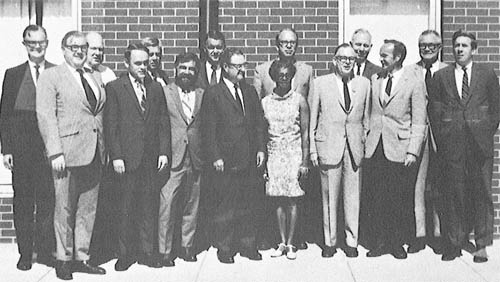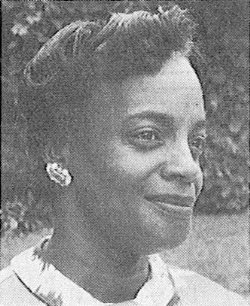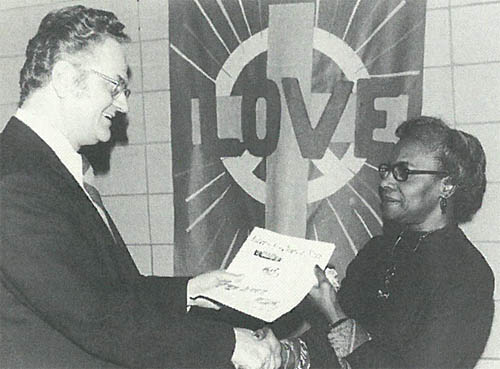 Looking at a photograph of the first group of Metropolitan Council members—appointed by Governor Harold LeVander in 1967—it’s impossible to miss the sole woman in the group. She’s about five feet tall, African American, and the only person of color amid 14 white men.
Looking at a photograph of the first group of Metropolitan Council members—appointed by Governor Harold LeVander in 1967—it’s impossible to miss the sole woman in the group. She’s about five feet tall, African American, and the only person of color amid 14 white men.
The caption identifies her as “Mrs. James L. Taylor.”
H. Janabelle (pronounced JAY-nah-bell) Murphy was born in 1920. Though she grew up outside Saint Paul’s Rondo neighborhood, in a home near Hamline and Thomas avenues, she was well known in Rondo, said her eldest son, Lanny Taylor. For decades, Rondo was a large and thriving African American community. It was split in two in the early 1960s by the construction of I-94, when many blocks of houses and businesses were destroyed, and hundreds of people were displaced.
 At age 83, just 6 years before she died, Janabelle Murphy Taylor was interviewed as part of the Rondo Oral History Project, created by Hand in Hand Productions. She described how as a child, she spent many hours at the Hallie Q. Brown Community Center, a focal point for African American community life in Rondo.
At age 83, just 6 years before she died, Janabelle Murphy Taylor was interviewed as part of the Rondo Oral History Project, created by Hand in Hand Productions. She described how as a child, she spent many hours at the Hallie Q. Brown Community Center, a focal point for African American community life in Rondo.
“I was feisty. People used to take advantage of us little people, you know. I always had to show that I was as hefty as any of the bigger people,” she said.
While attending Central High School, she volunteered at Hallie Q. Brown. She worked there part-time while earning a degree in physical education at the University of Minnesota. Upon graduation, she moved to New Jersey (where, Lanny reports, she dated Harry Belafonte) and then to Illinois. When she returned to Minnesota in about 1946, she was hired full-time at Hallie Q. Brown, where she organized programs for youth and adults. She soon met and married Jimmy Taylor, and they started raising a family.
Like some middle-class black men at the time, her husband worked for the Great Northern Railroad as a Pullman porter. Her mother, Ida Mae Murphy, lived with the family on Thomas Avenue. Lanny said his grandmother “was very instrumental in how we were raised. She was like our alternate mother.”
Educator, mentor and ‘spitfire’
 In time, Janabelle Taylor became a deacon and treasurer at Pilgrim Baptist Church. She also served on the board of the Saint Paul Council of Churches and was president from 1973 to 1975. Mary K. Murray Boyd remembers Taylor as someone who always had time for children, and was a part of all the teaching that went on at church, from the pulpit to the classroom.
In time, Janabelle Taylor became a deacon and treasurer at Pilgrim Baptist Church. She also served on the board of the Saint Paul Council of Churches and was president from 1973 to 1975. Mary K. Murray Boyd remembers Taylor as someone who always had time for children, and was a part of all the teaching that went on at church, from the pulpit to the classroom.
“She kept us true to the Rondo values: education, care for the elderly, sharing and helping,” Boyd said. “Young people were encouraged to be whoever you want to be, and to remember that you were representing yourself, your family and your people.”
At Hallie Q. Brown, Taylor was “a fixture,” Boyd said. “She was a spitfire. She was a little woman, and not afraid to speak up, either to power or to kids. She would say her piece, but she did it in a way that was not a putdown.”
Again, from Taylor’s interview for the Rondo Oral History Project: “I love people. I wouldn’t have had any other kind of job.”
First Council was decidedly nonpartisan, Durenberger says
It was no doubt her prominence in the community that led to Taylor’s Council appointment, said former U.S. Senator David Durenberger. He served as Gov. LeVander’s executive secretary (the equivalent of chief of staff) when the Council was formed in 1967.
 The Council was such a significant change in the political landscape, and was so associated with the Republicans that created it, that Gov. LeVander “was determined to get this thing right,” Durenberger said. They didn’t want to politicize the Council, he said, so they appointed prominent, very competent people from both major parties to serve on it.
The Council was such a significant change in the political landscape, and was so associated with the Republicans that created it, that Gov. LeVander “was determined to get this thing right,” Durenberger said. They didn’t want to politicize the Council, he said, so they appointed prominent, very competent people from both major parties to serve on it.
“The governor wanted appointees to represent the nature of the districts from which they were chosen,” Durenberger said. “At the same time, [the appointees] needed to understand that they were working in a larger regional context. They were not there to represent folks from [a particular community] or political party.” He also noted that African Americans were less identified with the DFL Party in the 1960s in Minnesota than they are today.
Speaking up for affordable housing
Retired Council Policy Analyst John Kari remembers Taylor. Kari was involved in writing the Council’s first Development Guide chapter on housing, in which Taylor had a strong interest. A controversial piece of the draft housing chapter was Policy 13, Kari said. The policy stated: “Assign a lower priority in the review of federal funding requests to municipalities where plans and ordinances do not provide for low- and moderate-income housing.” The policy was strongly supported by the faith communities, but many elected city officials opposed it behind the scenes, Kari said.
During a meeting of the Development Guide Committee when Policy 13 was discussed, it was suggested that the policy be discarded. Taylor made a short speech about the importance of affordable housing and how the policy was the right thing to do, Kari remembers. Donald Dayton, uncle of the current governor, got on board, and several other Council members soon followed suit.
“She didn’t speak up often, but when she did, they listened,” Kari said. “She was rock solid; she had a lot of integrity.” The motion passed.
Taylor served on the Council through March 1971.
Taylor remembered fondly by people she guided as youths
Many people still remember Taylor because she touched the lives of so many youths in the community. She worked for 40 years at Hallie Q. Brown, until her retirement in 1982. As part of her role there, she led Head of the Rapids summer camp at St. Croix State Park, near Hinckley, for at least two decades. The campers were racially diverse.
Johannes Allert, who grew up in St. Paul Park and Cottage Grove, was a counselor at the camp. “The word ‘indefatigable’ matches Mrs. Taylor,” he said. “She had energy and stamina.”
Jan Price, Saint Paul, was both a camper and a staff member at Head of the Rapids.
“Mrs. Taylor was a true leader,” Price said. “She cared so much for the staff. She was part of a generation that wanted to make a better world.”
More info
Learn more about how the Council has evolved over time, on the Council's 50th Anniversary page.